Journey Around The Globe
ready for the next destination
Rome
Rome, Italy: Caput mundi, Eternal City, “Capital of the ancient western world and capital of Christendom” … they all refer to one place on earth, Rome, Italy. Situated by the river Tiber, Rome is one of very few cities in the world that can boast 3,000 years of uninterrupted civilization. Archeologists traced early settlement of farmers/herders in this site from 753 BC. This was once the administrative center of the mighty Roman Empire, governing a vast region that stretched all the way from Britain to Mesopotamia. Rome’s history is long and complex. Along with its ancient history, todays modern Rome is very well-known for its culture, fashion lines, food, and many other things.

I was never so excited to visit a city as I was for Rome and I have to say that this trip was the best one among all the other ones we made so far. It gave me chills wandering in the streets of Rome, especially when I could relate words like Renaissance, Baroque, Julius Caesar, Roman Catholicism, Roman emperor with the city. It is a beautiful city with big basilicas, majestic palaces which are surrounded by tiny alleys, little churches and old houses. The city is built around ruins one older than the other. There are surprises waiting to be discovered at every corner of Rome. It is definitely one of the most charming cities in the world.
Time of Traveling: We traveled to Rome during first week of November, 2011 and spent 5 days and 6 nights there. It was a bit chilly but sunny the first few days, while the last 2 days were wet and rainy.
Hotel We Stayed in: We stayed in Hotel Gioberti near Roma Termini (the main train station in Rome). There are lots of other hotels near Termini to choose from. It is a safe place as long as you stay close to populated areas. There are lots of shopping places and café/restaurants in this area, where you will find local to international cuisines. Colosseum, Pantheon, and other piazzas are only 15-25 minutes of walk from the hotel. It costs about 15 euros one-way to go to Vatican City on a metered taxi from here. We mostly walked to all the main attractions, except for the Vatican City. Also, since the Termini is close by, you can always take tram/train/bus to anywhere.
What to buy from Rome: Pasta comes in different shapes and color in Italy. So make sure you buy some while in Rome. There are lots of gourmet food items also available like pasta sauce, olive oil, preserved olives, and etc. Murano glass decoration and jewelries are very famous here if you have some extra money to spare. Paintings are almost a must to buy item. Finally, leather items, like purses, boots, and coats are famous as well.
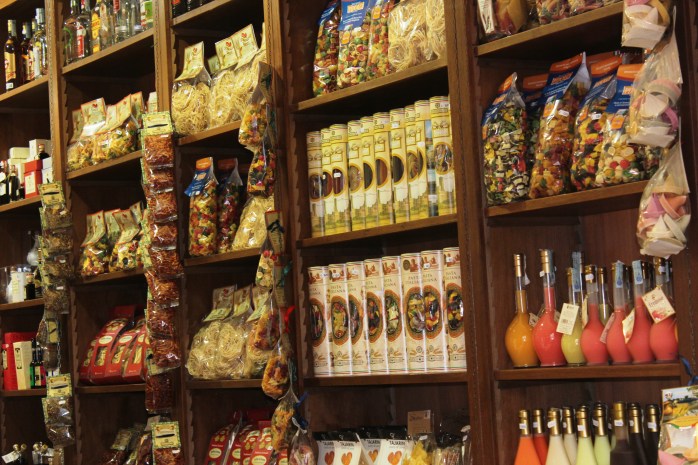
Places we visited: I have compiled the places we visited in different categories: Ancient buildings and ruins, churches/cathedrals, castles/palaces, fountains, government buildings and piazzas.
1) Ancient buildings and ruins:
a) Colosseum: I guess no need to say much about the Colosseum. But here is brief background info. It is the largest amphitheater ever built in Rome and considered one of the greatest works of Roman architecture and Roman engineering. The construction of Colosseum started in 72 AD and was completed in 80 AD. Capable of about 50,000 spectators, it was mainly used for gladiatorial contests along with other entertainments in the early medieval era. The underground of Colosseum was known as the backstage where all the slaves, animals, fighters, and machineries were kept. There is a section with white limestone steps in the spectators’ area, which was once seats for the senators, VIPs and Royalties. I felt so small in front of those big walls of Colosseum and its history. Try to feel the excitement of a fighter in front of 50,000 audiences when visiting this magnificent architecture.

You get a great view of Arch of Constantine, Roman Forum from the top-level of Colosseum. If you are traveling with kids, it is not a stroller friendly place, since you have to climb a great number of stairs to go to the top-level with hundreds of other tourists. Unfortunately there is no facility to store the stroller either. So, even though it is a bit hard, carrying the stroller is the only option we had. The entry to Colosseum is 8 euros per person, which includes entrance to Roman Forum, and this is valid for 24 hours. It is best to combine Colosseum and Roman Forum in one day.
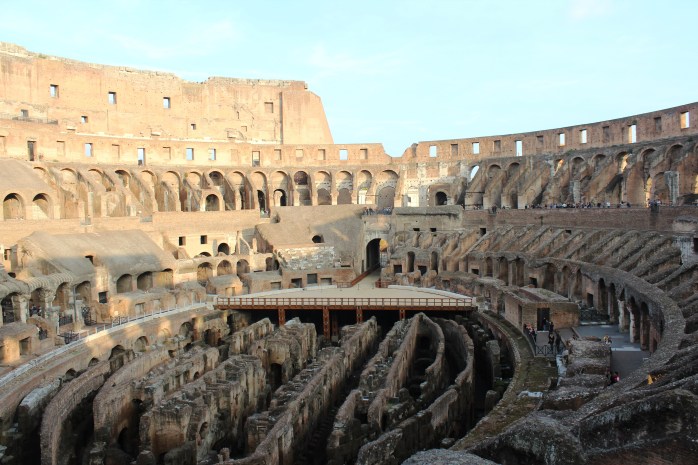
b) Pantheon: Pantheon is the only large monument of ancient Rome which is well preserved. It is just not the oldest church in Rome but also mausoleum of the royal family (unified Italy’s 1st King Vittorio Emmanuel II and 2nd King Humbert I & Queen Margherita Savoia) and renaissance artist Raphael. Pantheon was erected in 27 AD by Agrippa, son-in-law of Emperor Augustus, but later on it was completely rebuilt in 123 AD by Emperor Hadrian. The temple was dedicated to all the pagan Gods worshipped by the Romans. In 608, it was converted into a church. The circular oculus on top of the dome is the only source of light in Pantheon. There is actually a hole on top and one of the best places to enjoy a rainy day in Rome is definitely inside Pantheon. The floor has a slope towards the side to drain rain water accessing from the empty hole on top.
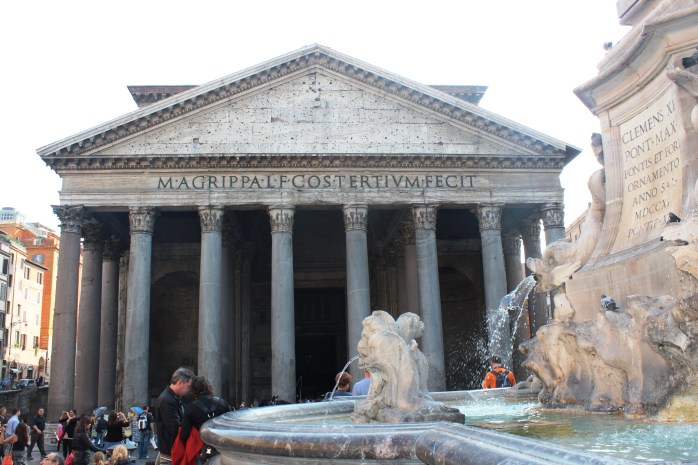
Pantheon is surrounded by lots of old, colorful buildings. There is a beautiful fountain right in front of Pantheon. It is a perfect place for lunch or dinner and some shopping. Piazza Navona is about 5 minutes walking from here.
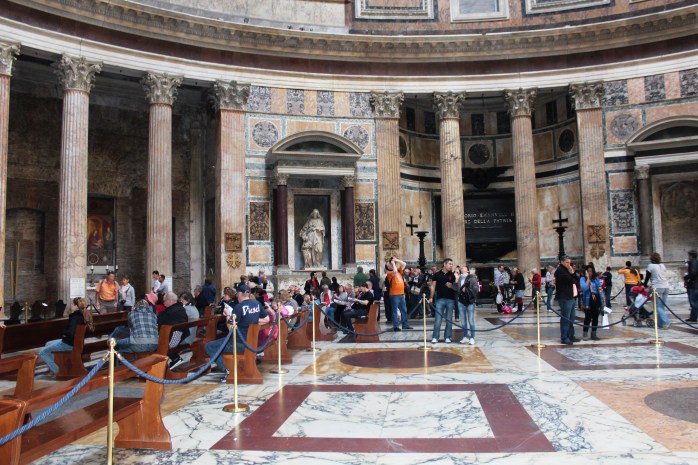
c) Roman Forum: Roman Forum was the center of daily life in Rome during 8th and 7th century BC. It included temples, markets, courts, many public buildings, horse racing, gladiator matches, banquets and many other activities. After various transformations, the Roman Forum became so large as to be considered the secular, religious and commercial center of the city in Augustus’ time. With the decline of the Roman Empire, these structures of the forum were severely damaged during the barbarian invasions, civil wars and floods. Debris built up over Rome and eventually it was buried. People left to find other places to rebuild and live. It was not until the early 20th century when the systematic excavation started, which lasted from decades till now. Today, you can see the ruins of Arch de Constantino, Arch de Titus, Arch de Septimus Severus, Temple of Saturn, Temple of Divus Julius, Temple of Divus Romulus, Temple of Venus, Temple of Rome, Palace of Augustus, and many more inside Roman Forum.

This is a must see when in Rome, otherwise you cannot feel the real ancient civilization of Rome and how people lived here hundreds of years ago. As I mentioned before, you can use your Colosseum ticket to visit Roman Forum, but it has to be within 24 hours of purchase. This is a not a stroller-friendly or wheelchair friendly area at all. We had really hard time pushing the baby-stroller through all the rocks, up/down areas, and stairs. It is also a good idea if you can pack some small snacks/drinks since there is no café/vending machine/restaurants inside the forum. There are many gates to enter Roman Forum and plan to stay at least half a day or more here to walk and explore the incredible sites. The gates open at 8:30 am and are open till 4:30 pm during winter season. Don’t forget to visit 2 small museums inside the forum: a) Curio (near Arch de Septimus Severus and Temple of Saturn, b) Temple of Divus Romulus.

d) Tempio Adriano: Temple of Adrian was built in 145 AD to honor King Adrian. It is located in Piazza di Pietra. One side with 11 columns still remains there. You can walk by it or spend some time in the piazza; you cannot go inside the temple.

2) Churches and Cathedrals:
a) Basilica of Santa Maria Maggiore: The church is located in Piazza Santa Maria Maggiore. This one of the four Papal churches in Rome which is patrolled by the Vatican City force and not by Italian police. This present church was built around 432 AD. Enjoy the gorgeous marble floor and columns inside the church. There is also a small museum which was opened recently in 2010; it displays most precious objects belonging to the basilica, like books, monstrance, chalices, paintings, and liturgical vestments.
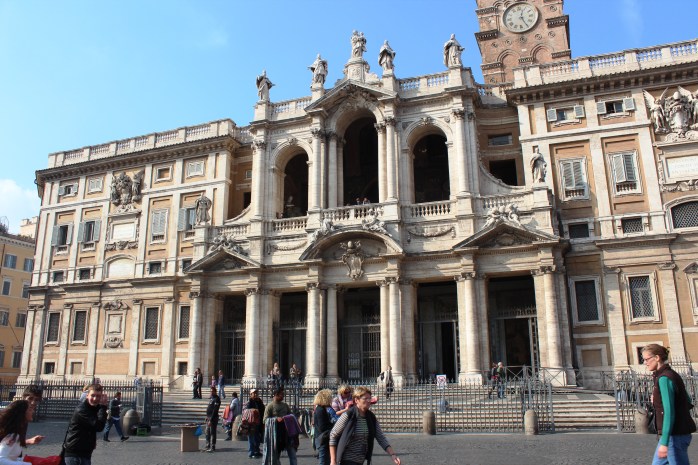
3) Castles and Palaces:
a) Castle Sant’Angelo: The castle, originally the mausoleum of the emperor Hadrian and his family, was built in 139 A.D as his final resting place. It was designed and ordered by Emperor Hadrian himself. The magnificent bridge that leads to Castle Sant’Angelo across the River of Tiber is Ponte Sant’Angelo, which was built around 130 A.D. The castle has been many things throughout history. In 401 A.D, it was turned into a military fortress and it was later used by many popes as fortress. The passetto was built in the 14th century, which is a passageway that connects the castle to the Vatican, so that the pope could escape if the Vatican was besieged. Around 520 A.D., it was also used as a prison.

The present name of the castle refers to the sculpture of the archangel Michael seen on top. In 590 A.D. Rome was struck by the plague. Saint Gregory the Great was pope at that time. The story goes that one day he led a procession through the city asking God to end the plague. When the procession reached the mausoleum (as it was then), the pope saw a vision of an angel sheathing his flaming sword at the summit of the conical roof, which he took as a sign that the epidemic would soon cease. From that moment on the fortress took the name of Castel Sant’Angelo.

You have to visit this castle when in Rome, especially if you watched the movie “Angels and Demons (Tom Hanks). They shot a portion of the film here. May be it is a good idea to combine this with Vatican City. The bridge Ponte Sant’Angelo is adorned by a double row of angles (work of Bernini followers), including statues of St. Peter and St. Paul at the beginning of the bridge. The castle looks gorgeous during both day and night. We were lucky to get both views. There is a lovely café/restaurant on the terrace of the castle, where you can get coffee/gelato etc. while enjoying the view of Basilica St. Peter. You also get a stunning panoramic view of the whole city from there. If you are traveling with kids, you cannot take the stroller inside the castle; have to park it near the ticketing area. The admission is 8 euros per adult and it is closed on Mondays; other days it is open from 9 am – 6:30 pm.
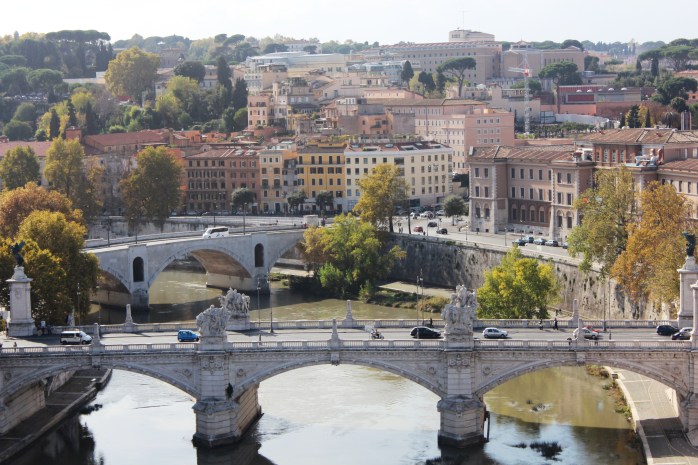
b) Villa Borghese: Villa Borghese is a lovely part of Rome. The park is the largest in the city. Therefore, you can technically spend hours and hours here. The palace was originally built in 1560 for Cardinal Scipione Caffarelli Borghese and his family.
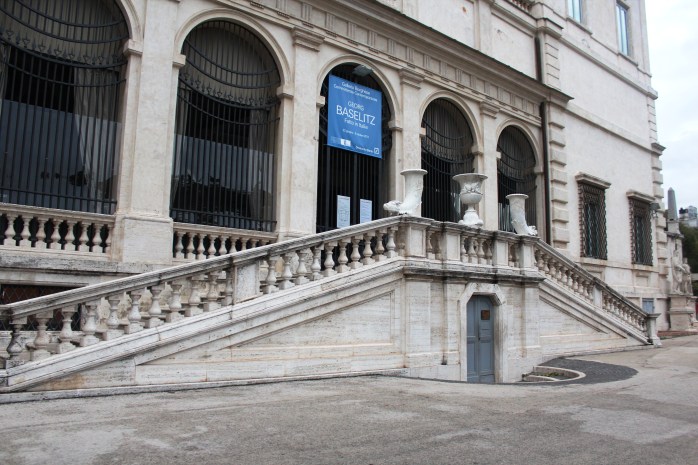
It is quite a long walk here from Piazza del Popolo. Best to either take a taxi or bus. We luckily found a sight-seeing trolley who took us around the garden and the palace. Unfortunately, the museum, palace, and the garden were closed by then. But it is a lovely, quiet place to hang around for a while.

4) Fountains: Rome is a city of fountains. Every piazza, every garden, almost all the big round-abouts have at least one fountain (if not two) with beautiful designs.
Trevi Fountain (Fontana Di Trevi): Trevi Fountain is the largest, most famous and most spectacular fountain of Rome. It was built in 1730 to glorify three different Popes: Clements XII, Benedict XIV, and Clement XIII. The fountain is set against a large building and is decorated with statues which stand upon big rocks from which the water gushes out. The central figure is the God of Ocean, Neptune which dominates the scene from the high. A tradition legend holds that if visitors throw a coin into the fountain, they are ensured a return to Rome. An estimated 3,000 euros are thrown into the fountain EACH DAY by the tourists.
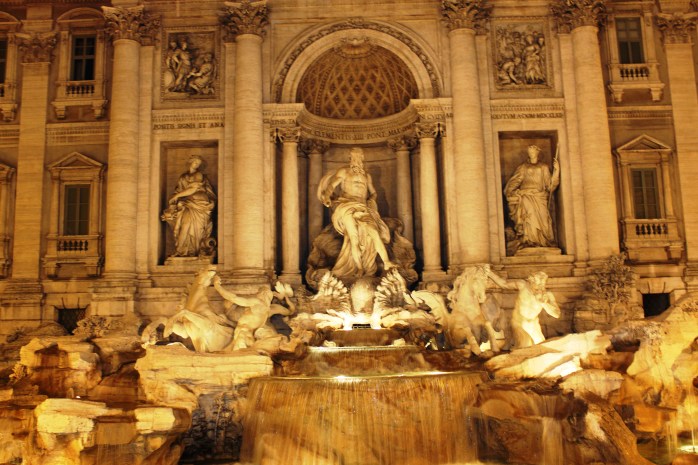
The Trevi Fountain is surrounded by many souvenir stores, leather stores, gelato bars, cafes and pizzerias. It is very close to Spanish Steps (Piazza di Spagna) if you want to combine the trip. The fountain looks absolutely extraordinary during the day time as well as at night. Be careful of your belongings here, since it is a very crowded place at any time of the day.
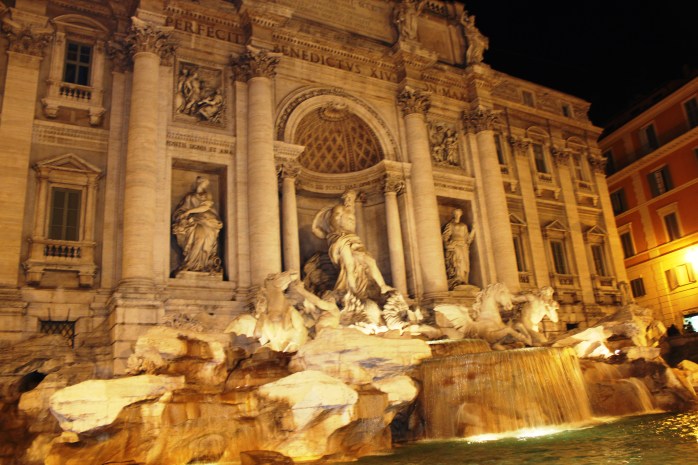
5) Governmental Buildings: I don’t have much information on these following governmental buildings. We just saw them from outside. I am not sure if they have any guided tour to visit inside. But here is some information anyways.
a) Presidential Palace & Italian Supreme Court: They both are located in Piazza del Quirinele. You get a nice long distance view of St. Peter’s Basilica from here. It is only about 5 minutes of walk from the Trevi Fountain.
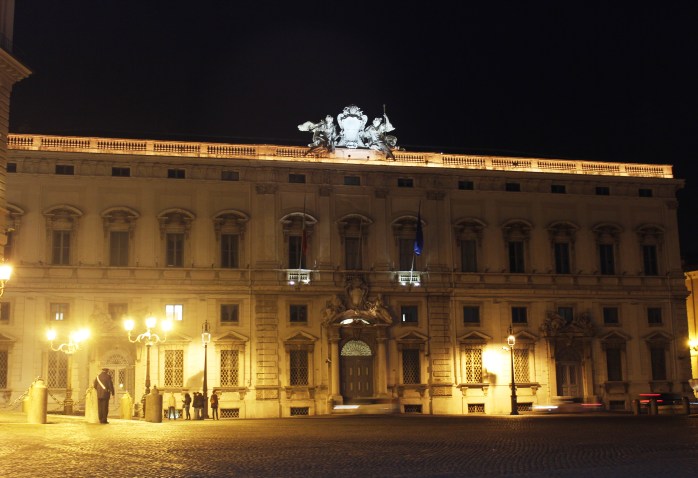
b) Italian Parliament: This is located in Piazza Di Monte Citorio, which is right beside Piazza Colonna.
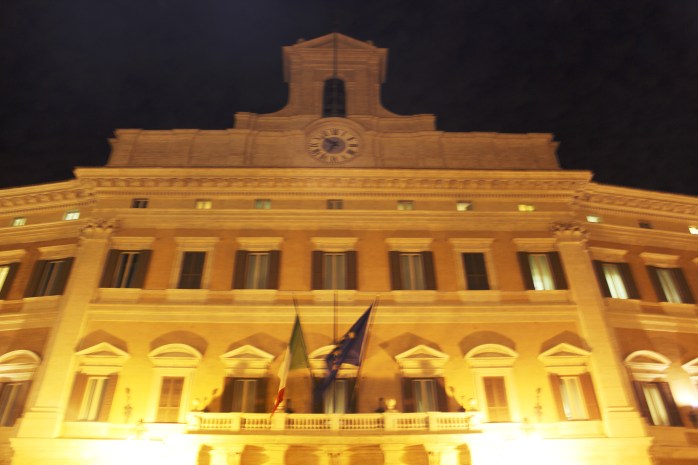
6) Piazzas: The narrow streets of Rome frequently broaden out into small or large squares (piazzas), which usually have one or more churches and may be a fountain or two. Most of these piazzas are surrounded by cafés, shops, gelato bars, and etc. You will see some talents on the streets here. Here are the ones we visited:
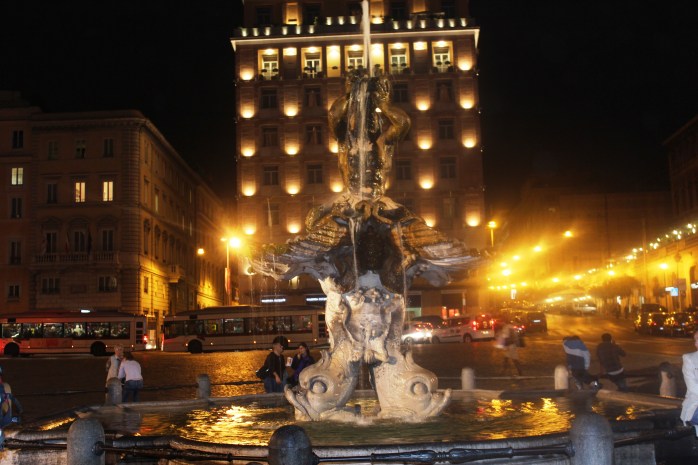
a) Piazza Navona: This one is my most favorite piazza. You can literally spend hours here. This was Rome’s public market square in the 16th century. There are 3 fountains here: Fontana dei Quattro Fiumi (Fountain of 4 rivers -1651 A.D.) is the one in the center which represents 4 rivers…the Danube, the Ganges, the Nile, and the Rio de la Plata, Fountain of the Moor at the south end and the Fountain of Neptune at the northern end of the square. Piazza Navona may be only 5 minutes of walk from Pantheon. This is one of the best places to have lunch, enjoy the fountains, Baroque Rome, and the street performers all at the same time. This is also a great place to buy original oil on canvas or water color paintings. One 8” x 10” oil on canvas painting costs around 50 euros and same size for water color costs about 20 euros. But the bigger sizes are around 80 euros. Make sure you bargain to get a good deal.

b) Piazza Campo di Fiori (Field of the flowers): This is one of the liveliest piazzas in Rome, especially in the morning. Though we didn’t visit this place in the morning, but that’s when all vendors gather around with their wares: fruits and vegetables, meats and cheeses, clothing and household goods, and not to mention the flowers. The piazza is surrounded by picturesque small buildings, charming shops, cafés, and taverns. This is very close to Piazza Navona, may be 5 minutes of walk… don’t miss it.

c) Piazza di Spagna (Spanish Steps): This place took its name in the 17th century when the site was a Spanish territory when the Spanish Embassy to the Holy See was located here. At the bottom of the Spanish Steps you will see Fontana dela Barcaccia (Fountain of the old boat), which is a nice baroque fountain with a shape of a sunken ship. The fountain was erected in 1627 by Pietro Bernini and his son. It is the luxury center of the city, and one of the most exclusive and expensive shopping areas in the world. All the top names you can think of have stores here. Check out Via Condotti and other nearby small streets to look for your favorite brand. The 138 steps will take you to the beautiful 16th century French church, Trinita dei Monti. The majestic staircase was built around 1725 to celebrate the peace between Spain and France. Interestingly, these steps are the longest and widest staircase in Europe. You can find lots of paintings here too in front of the French church. But with less variety.

At the bottom of the stairs, if you are facing the church, there is a tea shop, called Babington’s Tea Room, which offers rare blends of tea and delicious breakfast, lunch, and snack specialties. The history goes back in 1893, when tea was still sold in pharmacies in Italy. Two enterprising English women, Anna Maria Babington and Isabel Cargill, journeyed from England to Rome and opened this unique establishment. Since then, the tea room and shop has perpetuated an exquisitely English taste and atmosphere at the original premises in Piazza de Spagna.

d) Piazza del Popolo (Square of the People): This is very close to Piazza de Spagna. It is a huge open space with 3 fountains. It provided an imposing entrance to the city when it represented the northern boundary of Rome.
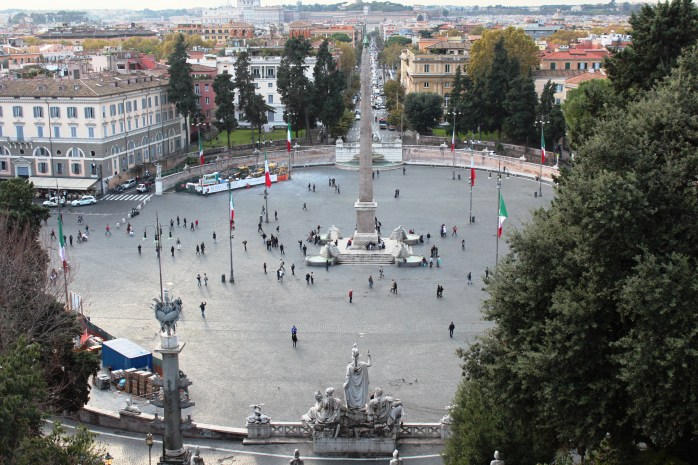
e) Piazza Venezia: This piazza is very famous for Monumento Nazionale a Vittorio Emanuele II (National Monument to Victor Emmanuel II), that honors Victor Emmanuel II, the first king of united Italy. It faces Piazza Venezia and back on the Capitoline Hill. The monument is built of pure white marble and features majestic stairways, tall Corinthian columns, a huge sculpture of Victor Emmanuel II and two status of the goddess. The structure is 135 m wide and 81 m high. Designed by Giuseppe Sacconi in 1895 artists from throughout Italy contributed in making the sculpture and other works of art for it. The monument was finally completed in 1935 at a cost of $20,000,000.

At the center of the monument is the 40 foot long, 40 foot high bronze sculpture of Victor Emmanuel II. Rome’s largest statue had to be cast in 13 parts. The 13 foot long sword weighs 700 pounds; the horse weighs 4,000 pounds; the king’s pistol holders are over six feet long; and the head and helmet of Vittorio Emanuel weigh more than two tons.

The white marble of the structure sticks out amidst its neighboring reddish-brownish buildings. The gate is open every from 9:30 to 6:30pm to the public. It looks stunning both at night and during the day. There is also a museum up the stairs to your right, which is free of charge. You get a great view of the whole piazza and from the monument.
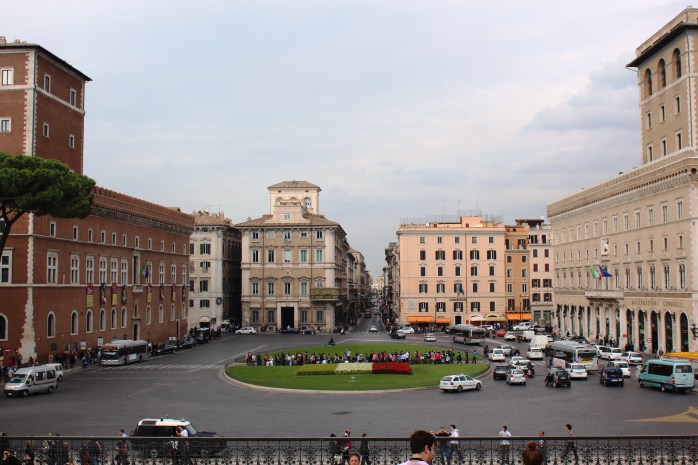
There are some other piazzas if you are interested: Piazza Republica, Piazza Bernini with a beautiful fountain, Piazza del Quirinele and lots more.
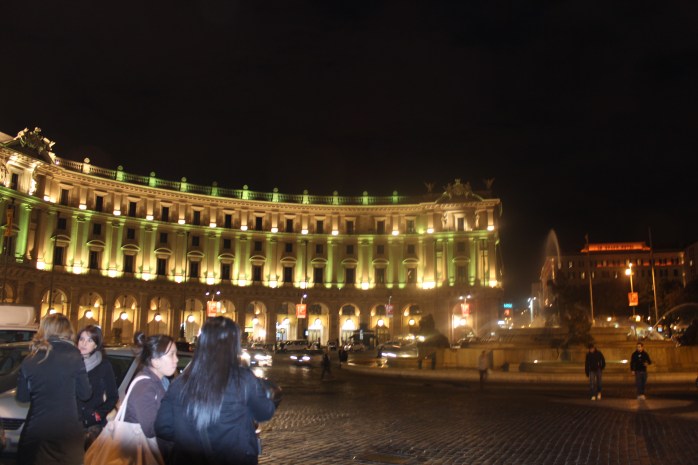
Related articles
- City Guide: Rome, Italy (insydetravel.info)
- Explore the ancient and modern with Rome in 3D (google-latlong.blogspot.com)
- Roman Forum, Colosseum, Saint Peter’s Basilica, OH MY! (eunabellacitta.wordpress.com)
- The legends of the Pantheon in Rome! (lostintown.wordpress.com)
- Luxury Weekend in Rome (ebookers.com)
- An Audio Tour through Ancient Rome (republic2empire.com)
- World Travel: Rome (therepublika.com)




Glorious photos! Molto grazie!
LikeLike
Thanks a lot 🙂
LikeLike
Very beautiful site! Now I’m following you, please come and visit my blog http://tricchetetracchete.wordpress.com
LikeLike
Great info I think I revisited Rome going thru your blog. I am definetly going to refer you blog to the places next I visit. I started bloggin last year and realised there are so many people out there looking fo rmore information on travel. 🙂 Keep it going.
LikeLike
Thank you, yes you are right. I try my best to give some facts and then put some of my own views on these places to help the travelers… Thats what I look for when going to a new place
LikeLike
I agree because even I am looking out for similar info. I just checked your entire blog you have visited most of the places in Europe. We have just started exploring Europe. 🙂
LikeLike
Oh good, I am sure you are enjoying the variety of culture and rich history of Europe.
LikeLike
We stayed in the hotel in your last photo, last October when we toured Italy. 🙂
LikeLike
Wow, I am sure you enjoyed the nigth view from of the piazza from your room..
LikeLike
Beautiful pics. It reminded me of when I used to live in Italy. Actually, if you look at your piazza navona picture…my apartment was on the top floor of the light colored building to the left of the fountain 🙂
LikeLike
Lucky you…it would be a dream for me to live in Piazza Navona…my most fav piazza in Rome
LikeLike
My grandson recently went to Rome and sent me some of these same pictures. The only problem is, he didn’t put any labels on them! Thanks for giving me place names for some of my pictures!
LikeLike
Oh wow, great, I am glad you found them useful 🙂 My pleasure
LikeLike